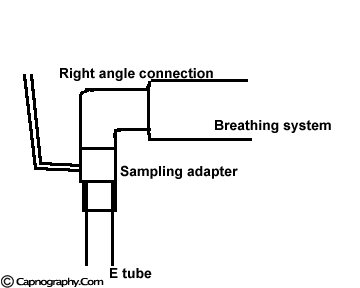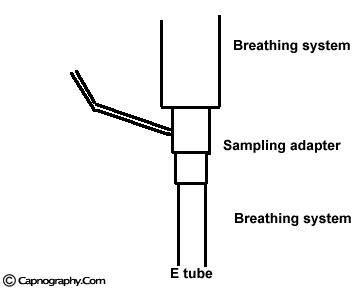Capnography tips
Minimize technical problems in CO2 sampling
FGF can dilute PETCO2 measurements. A Right angle connection between the breathing system and the sampling tube increases the accuracy of PETCO2 measurements as shown below
| Right angle connection between the breathing system and the sampling tube increases the accuracy of PETCO2 measurements | FGF can dilute PETCO2 measurements |
 |
 |
Falsely low PETCO2 values frequently arise due to errors in sampling of the end-tidal gas. Admixture of end-tidal gas with fresh gas flow can occur during the use of T-piece breathing systems on the Ayre principle (eg., Jackson Rees, Bain anesthetic system) or during the use of certain lung ventilators, which produce constant flow. The problem of admixture of the end-tidal gas by the fresh gas flow from the breathing circuits can be minimized by interposing a right angle adaptor between the breathing system and the endotracheal tube, and interposing the sampling tube on the patient’s side of the angle piece.1
Admixture of end-tidal gas with air can result from leaks in the sampling system, poor anesthetic face mask fit and during sampling of end-tidal gas from the nasal cavity in mouth breathing patients
Tachypnea/ low tidal volumes
Caution is to be exercised while monitoring PETCO2 during low tidal volume frequent breathing. Errors can result for two reasons.
(a) With frequent low tidal volume breathing, exhalation may not be complete and alveolar gases may not have fully migrated to the patient’s airway. Therefore the end-tidal gas is not good representative of the alveolar gas.
(b) Analyzers may underestimate PETCO2 when breathing frequency is greater than 30 breaths.min-1, particularly if the response time of the analyzer is greater than the respiratory cycle time of the patient.
Under these circumstances of low tidal volume and frequent breathing during anesthesia the accuracy of PETCO2 can be improved by an assisted single large tidal volume. This is rewarded with adequate alveolar gas and measured PETCO2 (squeeze) is more representative sample of alveolar gas than the passive PETCO2. Therefore “squeeze PETCO2” could be used as the basis of assessing PaCO2 and, thus, alveolar ventilation.2,3
References:
1. Gravenstein N, Lamptang S, Beneken JEW. Factors influencing capnography in the Bain circuit. J Clin Monit 1985;1:6-10.
2. Sweadlow DB, Irving SM. Monitoring and patient safety. In Blitt CD (Ed.). Monitoring in Anesthesia and Critical Care Medicine. 2nd ed.,New York: Churchill Livingstone, 1990:33-64.
3. Bhavani Shankar K, Steinbrook R, Mushlin PS, Freiberger D. Transcutaneous carbon dioxide monitoring during laparoscopic surgery in pregnancy. Canadian J Anaesth 1998;45:164-9.

 Twitter
Twitter Youtube
Youtube









